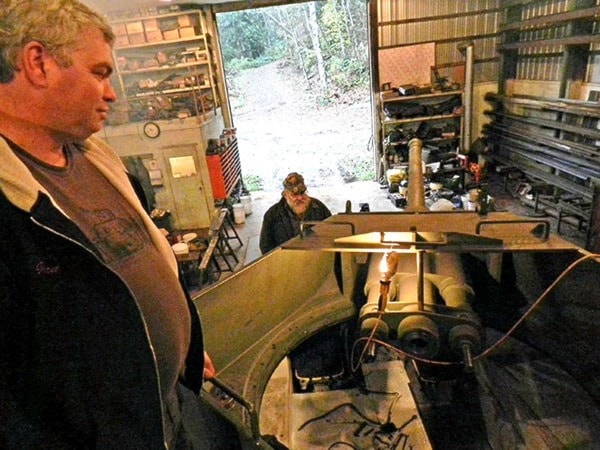The road climbs upward through the November mist from the flat of the Sumas Prairie below. Tires spin on the soddened leaves that carpet the narrow path. A sharp turn to the left and then to the right and the road opens on a clearing, framed by odd bits of abandoned machinery. A tank tread lies coiled in the grass.
At the centre stands a corrugated metal building two storeys in height.
Gord Wozencroft is at the door. There is a slight smile on his face.
Wozencroft, president of the Canadian Military Education Centre in Chilliwack, has hinted at a new vehicle he and museum secretary-treasurer Brooke Quam have been working on.
Inside, the damp air is heavy with the smell of grease and diesel. The walls are lined with equipment, tools and parts the pair has amassed over the years.
But at the centre, in the dim light, stands a 25-ton monster.
And it’s alive.
Quam wipes the oil from his hands and a smile stretches across his bearded face.
“It’s an Achilles Tank Destroyer,” the two say like proud parents.
“As far as I know there is nothing like this in Canada, maybe in North America,” says Quam. “As far as I know, this is the only one.”
The Achilles’ lineage can be traced to the height of the Second World War. It is variant of the American M10, but equipped with a 17-pounder cannon that remains the most effective anti-tank gun the Allies used during the war.
It was prototyped in Montreal, says Quam, and many were built in Canada.
That history makes it an important addition to the museum, the two say.
 They began collecting parts for the Achilles nearly four years ago and spent the last nine months building it. They still hope to have it running in time for the Remembrance Day service at the All Sappers Memorial this Monday. But while the Detroit Diesel engine growls to life when called upon, the transmission is less willing.
They began collecting parts for the Achilles nearly four years ago and spent the last nine months building it. They still hope to have it running in time for the Remembrance Day service at the All Sappers Memorial this Monday. But while the Detroit Diesel engine growls to life when called upon, the transmission is less willing.
Finding parts for a Second World War tank is difficult, says Quam. “Either you find the parts, or you have to make them.”
A piece of the turret mechanism was recently located by Wozencroft and shipped from Bosnia-Herzegovina.
Quam and Wozencroft know the challenges of rebuilding rare military machines. The two were responsible for refurbishing the Sherman tank ‘Caroline’ that was once at the Vedder Road cenotaph. That vehicle is now outside the headquarters of the 39th Combat Engineers in Chilliwack after a brief stay at the Education Centre.
The Achilles, once it’s finished, will remain at the centre. “We own it,” the two say.
The museum prides itself on the accessibility of its collection. Visitors are given hands-on exposure to the armoured vehicles that have shaped Canada’s military history.
And the Achilles plays a central role in that experience.
The vehicle was designed to counter the heavy weight thrown by German armour. Although the Sherman, main battle tank of the Allies, was effective, it lacked the punch to counter the more modern German tanks. The British response was to mount its lethal 17-pound anti-tank gun on a vehicle big enough to carry it, but light enough to retain mobility in the field.
Thus was born the Achilles.
Canadians trained on it, and used the American M10 (which had a different gun) as they fought their way through Italy.
In Europe, following the D-Day invasion in 1944, it was a key piece of equipment as the Allies slugged their way off the beaches of Normandy. Indeed, outside Caen, Canadian and British troops were involved in one of the most successful anti-tank battles of the invasion – 13 German tanks destroyed, to only four Achilles losses.
After the war, Quam says, the vehicles were returned to Canada, where they were used for training. When war broke out in Korea, they were shipped there, but exchanged for equipment more suitable to that battlefield.
Few returned. That’s why they are so rare in North America today.
Quam and Wozencroft are confident their functioning 17-pounder Achilles – with its unique open turret – will be a draw at the museum. They’re still undecided on a name for the vehicle, although research has indicated there was an Achilles in Europe named ‘Chilliwack.’ (They’ve talked about inviting the public to submit suggestions.)
The two are hoping technical issues with the transmission can be resolved by Remembrance Day. If so, it will join other vehicles from the museum at the All Sappers Memorial – once they figure out how to get it down off the mountain.
For more information on the Canadian Military Education Centre, go to www.cmedcentre.ca, or call 604.841.0710. The centre is located at 45540 Petawawa Road, Chilliwack.
